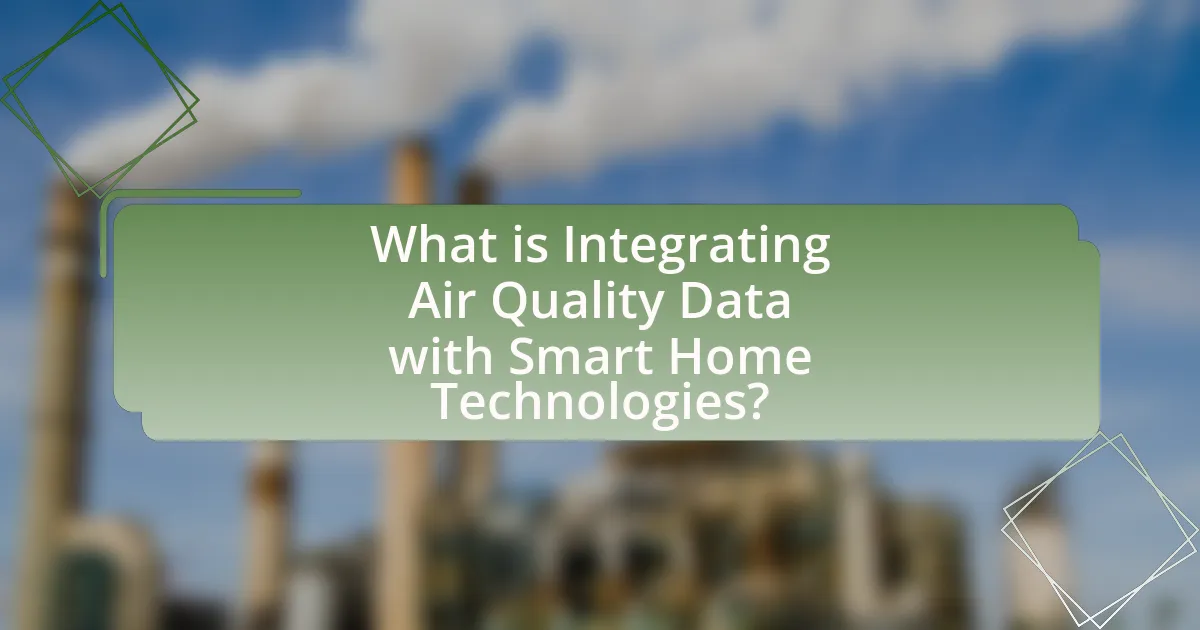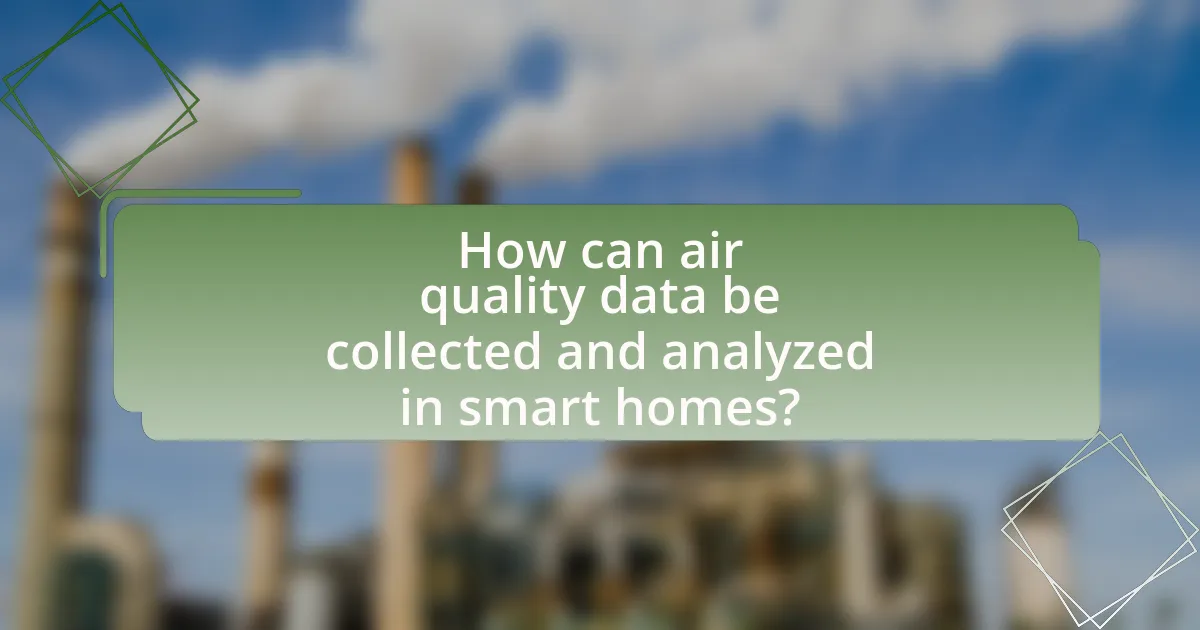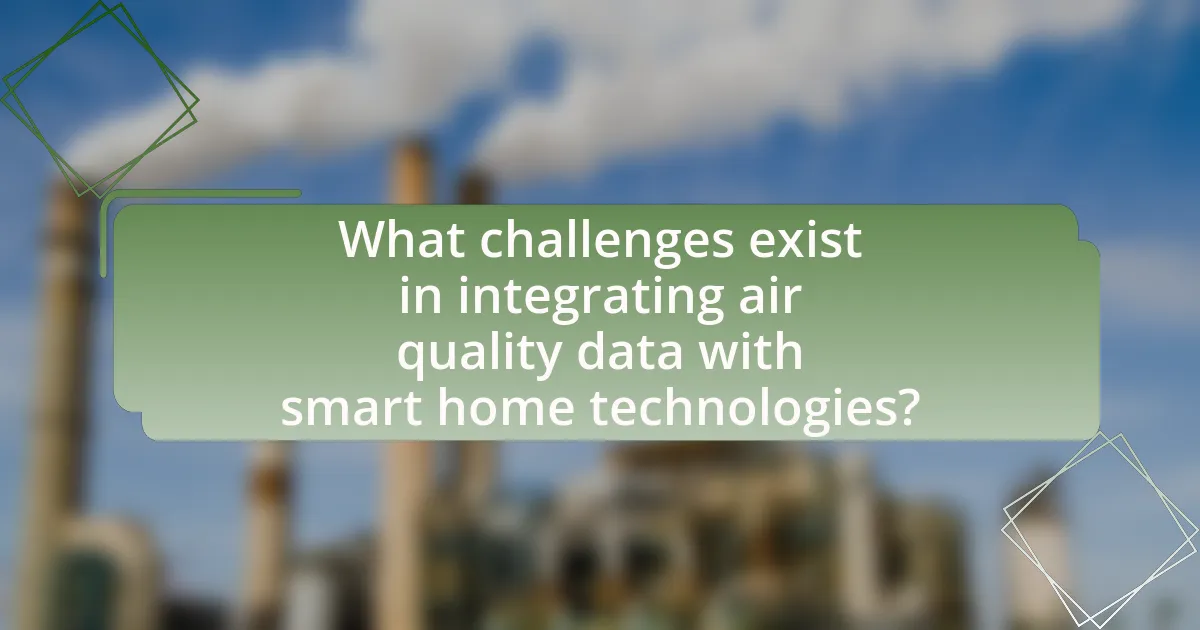Integrating air quality data with smart home technologies involves the use of sensors and devices to monitor and manage indoor air quality in real-time. This integration enhances smart home systems by enabling automated adjustments to ventilation, air purification, and temperature control based on detected pollutants and humidity levels. Key air quality metrics such as particulate matter, volatile organic compounds, and carbon dioxide are typically monitored, contributing to improved health outcomes and energy efficiency. The article also addresses the technologies used for data collection, the challenges faced in integration, and best practices for users to optimize air quality management in their homes.
What is Integrating Air Quality Data with Smart Home Technologies?

Integrating air quality data with smart home technologies involves the use of sensors and devices to monitor and manage indoor air quality in real-time. This integration allows smart home systems to automatically adjust ventilation, air purification, and heating or cooling based on the detected levels of pollutants, humidity, and other air quality indicators. For instance, a smart thermostat can lower energy consumption while ensuring optimal air quality by responding to data from air quality sensors, thereby improving health outcomes and comfort for occupants.
How does the integration of air quality data enhance smart home systems?
The integration of air quality data enhances smart home systems by enabling real-time monitoring and automated responses to indoor air quality conditions. This capability allows smart home systems to adjust ventilation, air purification, and heating or cooling based on detected pollutants or allergens, thereby improving occupant health and comfort. For instance, studies have shown that homes equipped with air quality sensors can reduce airborne contaminants by up to 50% through automated adjustments, leading to a healthier living environment.
What types of air quality data are typically integrated into smart home technologies?
Smart home technologies typically integrate various types of air quality data, including particulate matter (PM2.5 and PM10), volatile organic compounds (VOCs), carbon dioxide (CO2) levels, humidity, and temperature. These data types are essential for monitoring indoor air quality and ensuring a healthy living environment. For instance, studies show that elevated levels of PM2.5 can lead to respiratory issues, while high VOC concentrations are linked to indoor pollution and health risks. By incorporating these specific air quality metrics, smart home systems can provide real-time feedback and automate ventilation or air purification processes to maintain optimal air quality.
How do smart home devices utilize air quality data for improved functionality?
Smart home devices utilize air quality data to enhance their functionality by adjusting their operations based on real-time environmental conditions. For instance, smart thermostats can modify heating and cooling settings to maintain optimal indoor air quality, while air purifiers can activate automatically when pollutants exceed a certain threshold. This integration of air quality data allows devices to respond proactively, improving user comfort and health. Studies have shown that homes equipped with smart air quality monitoring systems can reduce airborne contaminants by up to 50%, demonstrating the effectiveness of these technologies in creating healthier living environments.
What are the key benefits of integrating air quality data into smart homes?
Integrating air quality data into smart homes enhances health, comfort, and energy efficiency. By monitoring pollutants and allergens, smart home systems can automatically adjust ventilation and air purification, reducing exposure to harmful substances. Studies indicate that improved indoor air quality can lead to a 20% reduction in respiratory issues and allergies. Additionally, real-time data allows homeowners to make informed decisions about their environment, optimizing energy use and potentially lowering utility costs.
How does this integration contribute to health and well-being?
Integrating air quality data with smart home technologies significantly enhances health and well-being by enabling real-time monitoring and management of indoor air quality. This integration allows for the automatic adjustment of ventilation systems based on detected pollutants, which can reduce exposure to harmful substances such as volatile organic compounds and particulate matter. Studies indicate that improved indoor air quality is linked to better respiratory health, reduced allergy symptoms, and overall enhanced cognitive function. For instance, research published in the Journal of Environmental Health found that effective air quality management can lead to a 30% reduction in respiratory issues among occupants.
What energy efficiency improvements can be achieved through this integration?
Integrating air quality data with smart home technologies can achieve significant energy efficiency improvements by optimizing HVAC systems based on real-time air quality metrics. For instance, smart thermostats can adjust heating and cooling settings when air quality deteriorates, reducing energy consumption while maintaining comfort. Studies indicate that homes equipped with smart technologies can reduce energy usage by up to 30% through such adaptive measures. Additionally, integrating air quality data allows for better scheduling of ventilation systems, ensuring they operate only when necessary, further enhancing energy savings.
How can air quality data be collected and analyzed in smart homes?

Air quality data can be collected and analyzed in smart homes using a combination of sensors, IoT devices, and data analytics platforms. Smart homes utilize air quality sensors that measure pollutants such as particulate matter, carbon dioxide, and volatile organic compounds. These sensors transmit real-time data to a central hub or cloud-based system, where advanced algorithms analyze the information to assess air quality levels.
For instance, a study by the Environmental Protection Agency indicates that real-time monitoring can significantly improve indoor air quality management by providing actionable insights. Additionally, integration with smart home systems allows for automated responses, such as adjusting ventilation or air purification systems based on the analyzed data. This approach not only enhances the living environment but also promotes health and well-being by ensuring optimal air quality.
What technologies are used for air quality monitoring in smart homes?
Technologies used for air quality monitoring in smart homes include sensors, IoT devices, and data analytics platforms. Sensors, such as particulate matter sensors and gas sensors, detect pollutants like PM2.5, CO2, and VOCs, providing real-time data on air quality. IoT devices connect these sensors to home networks, enabling remote monitoring and control through smartphones or smart home systems. Data analytics platforms process the collected data, offering insights and recommendations for improving indoor air quality. These technologies work together to create a comprehensive air quality monitoring system in smart homes.
How do sensors measure different air quality parameters?
Sensors measure different air quality parameters by utilizing various technologies such as electrochemical, optical, and infrared methods. Electrochemical sensors detect specific gases by measuring the current produced during a chemical reaction, allowing for the quantification of pollutants like carbon monoxide and nitrogen dioxide. Optical sensors, on the other hand, assess particulate matter by analyzing light scattering as particles pass through a laser beam, providing data on PM2.5 and PM10 levels. Infrared sensors measure gas concentrations by detecting the absorption of infrared light at specific wavelengths, which is effective for gases like carbon dioxide and methane. These measurement techniques are validated by their widespread use in environmental monitoring and regulatory compliance, ensuring accurate and reliable air quality assessments.
What role does data analytics play in interpreting air quality data?
Data analytics plays a crucial role in interpreting air quality data by transforming raw measurements into actionable insights. Through statistical analysis and machine learning techniques, data analytics identifies patterns, trends, and anomalies in air quality indicators such as particulate matter, nitrogen dioxide, and ozone levels. For instance, a study published in the journal “Environmental Science & Technology” demonstrated that data analytics could predict pollution spikes by analyzing historical air quality data alongside meteorological factors, leading to improved public health responses. This analytical approach enables stakeholders, including policymakers and homeowners, to make informed decisions regarding air quality management and smart home technology integration, ultimately enhancing environmental health and safety.
How is air quality data communicated within smart home systems?
Air quality data is communicated within smart home systems through a combination of sensors, wireless protocols, and cloud-based platforms. Smart air quality sensors detect pollutants and particulate matter, converting this information into digital signals. These signals are transmitted via wireless communication protocols such as Wi-Fi, Zigbee, or Bluetooth to a central hub or directly to cloud services. Once in the cloud, the data can be analyzed, stored, and accessed by users through mobile applications or smart home interfaces. This integration allows for real-time monitoring and automated responses, such as adjusting air purifiers or HVAC systems based on the detected air quality levels.
What protocols are commonly used for data transmission?
Commonly used protocols for data transmission include Transmission Control Protocol (TCP), User Datagram Protocol (UDP), Hypertext Transfer Protocol (HTTP), and Message Queuing Telemetry Transport (MQTT). TCP is widely utilized for reliable communication, ensuring data packets are delivered in order and without errors, making it essential for applications requiring accuracy, such as web browsing. UDP, on the other hand, is favored for applications where speed is critical, such as live video streaming, as it allows for faster data transmission without the overhead of error correction. HTTP is the foundation of data communication on the World Wide Web, facilitating the transfer of hypertext documents. MQTT is particularly effective in IoT environments, including smart home technologies, due to its lightweight messaging protocol designed for low-bandwidth, high-latency networks. These protocols are integral to the integration of air quality data with smart home technologies, enabling efficient and reliable communication between devices.
How do smart home hubs integrate air quality data from multiple sources?
Smart home hubs integrate air quality data from multiple sources by utilizing various sensors and APIs to collect, process, and display real-time information. These hubs connect to indoor air quality monitors, outdoor environmental sensors, and smart appliances, aggregating data such as particulate matter, humidity, and volatile organic compounds. For instance, a smart home hub can pull data from a dedicated air quality sensor and combine it with weather data from an online service, allowing users to receive comprehensive insights about their indoor and outdoor air quality. This integration enhances user awareness and enables automated responses, such as adjusting air purifiers or HVAC systems based on the aggregated data.
What challenges exist in integrating air quality data with smart home technologies?

Integrating air quality data with smart home technologies faces several challenges, including data standardization, interoperability, and real-time processing. Data standardization is crucial because various air quality sensors may use different metrics and units, making it difficult to create a unified system. Interoperability issues arise when different smart home devices and platforms do not communicate effectively, hindering the seamless integration of air quality data. Additionally, real-time processing of air quality data is essential for timely responses, but many smart home systems may lack the computational power or infrastructure to handle this data efficiently. These challenges can impede the effectiveness of smart home technologies in improving indoor air quality.
What are the technical limitations of current air quality monitoring devices?
Current air quality monitoring devices face several technical limitations, including sensitivity, calibration, and data accuracy. Many devices struggle to detect low concentrations of pollutants, which can lead to underreporting of air quality issues. Additionally, calibration requirements can vary significantly between devices, resulting in inconsistent data across different models. Furthermore, the accuracy of measurements can be compromised by environmental factors such as temperature and humidity, which can affect sensor performance. Studies indicate that consumer-grade devices often lack the precision of regulatory-grade instruments, leading to potential discrepancies in air quality assessments.
How can data accuracy and reliability be ensured in smart home systems?
Data accuracy and reliability in smart home systems can be ensured through the implementation of robust sensor calibration, regular software updates, and data validation techniques. Sensor calibration involves adjusting the sensors to provide accurate readings, which is crucial for monitoring air quality effectively. Regular software updates help to fix bugs and improve algorithms that process data, ensuring that the system operates optimally. Data validation techniques, such as cross-referencing readings from multiple sensors or using machine learning algorithms to detect anomalies, further enhance the reliability of the data collected. These methods collectively contribute to maintaining high standards of data integrity in smart home environments.
What privacy concerns arise from collecting air quality data in homes?
Collecting air quality data in homes raises significant privacy concerns, primarily related to data security and personal information exposure. The data collected can reveal sensitive information about occupants’ daily routines, health conditions, and lifestyle choices, which could be exploited if accessed by unauthorized parties. For instance, a study by the Electronic Frontier Foundation highlights that smart home devices can inadvertently disclose personal habits and preferences, leading to potential misuse of the information. Additionally, the aggregation of air quality data with other smart home data can create detailed profiles of individuals, increasing the risk of surveillance and targeted advertising.
How can users effectively utilize air quality data in their smart homes?
Users can effectively utilize air quality data in their smart homes by integrating it with smart home devices to enhance indoor air quality management. By connecting air quality sensors to smart thermostats, users can automatically adjust ventilation and heating systems based on real-time air quality readings, ensuring optimal air conditions. For instance, when particulate matter levels rise, smart air purifiers can be activated to filter pollutants, improving overall air quality. Studies show that maintaining good indoor air quality can reduce respiratory issues and enhance overall well-being, making the integration of air quality data with smart home technologies a practical approach for healthier living environments.
What best practices should users follow for optimal air quality management?
Users should regularly monitor indoor air quality using smart sensors to ensure optimal air quality management. These sensors can detect pollutants such as volatile organic compounds (VOCs), particulate matter, and humidity levels, providing real-time data. Research indicates that maintaining indoor air quality can reduce respiratory issues and improve overall health, as poor air quality is linked to various health problems. Additionally, users should ensure proper ventilation by using exhaust fans and opening windows when outdoor air quality is acceptable. Implementing air purifiers with HEPA filters can also significantly reduce airborne contaminants. Regular maintenance of HVAC systems is crucial, as clean filters and ducts enhance air circulation and quality.
How can users troubleshoot common issues related to air quality data integration?
Users can troubleshoot common issues related to air quality data integration by systematically checking data sources, ensuring compatibility, and verifying network connections. First, users should confirm that the air quality sensors are functioning correctly and that they are compatible with the smart home system. This can be done by reviewing the manufacturer’s specifications and ensuring that the data format aligns with the integration requirements. Next, users should check the network connections, as unstable or weak Wi-Fi signals can disrupt data transmission. Additionally, users can consult the integration platform’s documentation for troubleshooting steps specific to their setup. If issues persist, reaching out to customer support for the air quality device or the smart home system can provide further assistance.

Leave a Reply